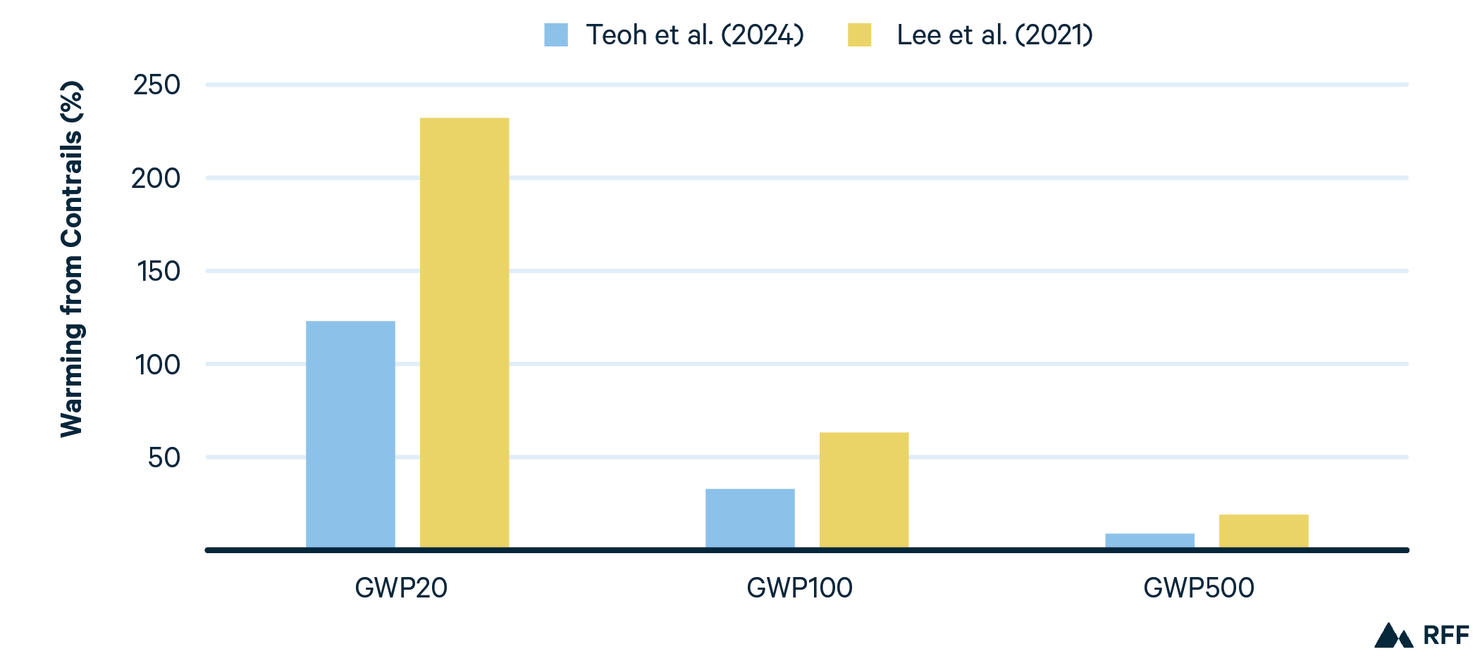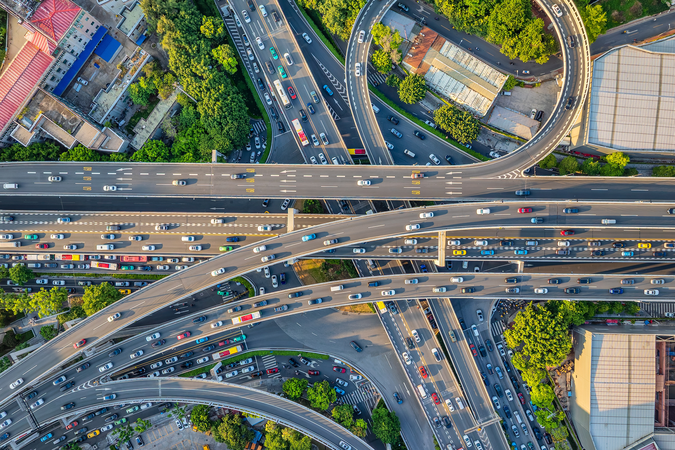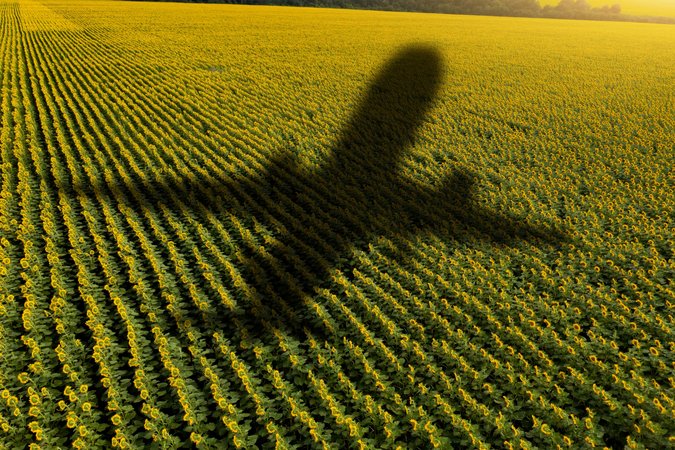Contrails, Aviation, and Climate Change
This issue brief explores how contrails are formed from the combustion of jet fuel, how contrails effect the climate, and what can be done to reduce them.
Aviation impacts the climate in several ways. In addition to carbon dioxide (CO2) emissions from the combustion of jet fuel, there are also the climate impacts of nitrogen oxides, particles, water vapor, and condensation trails, or contrails, white cloudlike streaks sometimes visible in the sky. Out of the non-CO2 effects, contrails are the most important, and in terms of climate impacts, they are broadly comparable to the carbon dioxide emissions from aviation.
How are contrails formed? How do they affect the climate? And what can be done to reduce them? In this paper, we try to answer these questions.
1. Formation of Contrails
Condensation trails were first observed toward the end of World War I when airplanes began flying high enough for the trails to form. In the summer of 1919, for example, pilot Franz Zeno Diemer set an unofficial world record by reaching an altitude of 9,300 meters during flights near Munich (Schumann, 1996).
Contrails consist of ice crystals and are essentially artificial clouds, but they form in a specific way. When jet fuel burns in aircraft engines, it produces carbon dioxide (CO2), water vapor, nitrogen oxides, and numerous airborne particles (called aerosols), which include soot and sulfur. In brief, contrails can form only when the plume is supersaturated with vapor—more technically, when the relative humidity with respect to liquid water exceeds 100 percent in the air masses that develop as exhaust mixes with the surrounding atmosphere.
Whether this threshold is reached depends on the balance between the added water vapor and heat from the exhaust and the humidity and temperature of the surrounding air. The more water vapor emitted, the larger the likelihood of contrail formation; conversely, more heat decreases the likelihood, since warmer air can hold more water vapor. A thermodynamic explanation of this balance is provided by the Schmidt-Appleman criterion, formulated in the 1940s (Schumann, 1996). These conditions are typically met when the ambient temperature is below approximately –40°C. Aircraft generally need to reach altitudes of around 8 kilometers (though the exact altitude can vary by several thousand meters, depending on the season and latitude).
A final key factor for the formation of contrails is the presence of condensation nuclei in the air. Such particles are supplied primarily by the combustion process but are also naturally present in the atmosphere. If particles are present and the Schmidt-Appleman criterion is met, water vapor from the exhaust can condense into microscopic water droplets, which then freeze into ice crystals. These ice crystals are what we see in the sky as contrail streaks left behind by planes.
1.1. A Thought Experiment
To understand the process better, imagine that planes become more energy-efficient. What would happen then? Less heat would be added to the exhaust mixing with the surrounding air. This would result in a lower temperature for this air parcel (all else being equal), reducing its ability to hold water vapor and thus increasing the likelihood of contrail formation. Paradoxically, more efficient planes could lead to a greater chance of contrails forming.
1.2. What Happens to Contrails After They Form?
Most contrails sublimate relatively quickly after forming, often within minutes. Sublimation is similar to evaporation but involves a transition directly from ice to water vapor. This is something you can observe when watching planes in the sky: Rather often, the contrails simply disappear after a brief period.
However, some contrails last much longer, lasting for several hours or up to a day. These persistent contrails are significant from a climate perspective.
For contrails to persist this long, they must form in regions where the ambient atmospheric air masses are supersaturated with respect to ice (i.e., the relative humidity with respect to ice exceeds 100 percent). Under these meteorological conditions, water vapor continues to deposit onto the ice crystals, causing them to grow. These ice crystals can then spread out into thin clouds known as contrail cirrus. Over time, these aviation-induced clouds become indistinguishable from natural cirrus clouds, which are high-altitude clouds consisting of ice crystals.
Studies have shown that approximately 5 percent of all flight kilometers result in the formation of persistent contrails.
2. Climate Impact from Contrails and Carbon Dioxide
Contrails have both cooling and warming effects on the climate. They cool the climate by reflecting incoming solar radiation back into space, while they warm the planet by trapping heat radiating out from Earth’s surface.
However, the net effect on a global scale is warming. On average, this warming (effective radiative forcing) corresponds to about 0.03–0.06 watts per square meter (W/m²), according to the central estimates of Teoh et al. (2024) and Lee et al. (2021), respectively. From a climate perspective, this warming accounts for about 1–2 percent of the current effective radiative forcing—that is, warming of the planet caused by carbon dioxide and other major greenhouse gases. So, contrails are clearly not the main driver of climate change.
Nevertheless, they are a significant contributor to aviation’s total climate impact. The current warming effect from all the carbon dioxide emitted by aviation so far amounts to about 0.03 W/m². Hence contrails from one year of aviation today warm the climate by as much—or maybe even twice as much—as the warming effect (this year) from the CO2 emissions from all previous flights.
2.1. Comparing Contrails with CO2 from a Particular Year or Flight
To compare the climate impact of contrails from aviation with that of carbon dioxide from a particular year or a particular flight, we have to take a forward-looking approach. This means we have to take into account the fact that contrail cirrus persists in the atmosphere for only a few hours, or up to a day at most, whereas carbon dioxide remains for much longer—about 40 percent of emissions still exist after 100 years, and 20 percent after 1,000 years. It takes tens of thousands of years for the last remnants to disappear.
Thus the importance of contrails versus carbon dioxide in global warming depends on the time horizon of the analysis. Over a 100-year period using the global warming potential (GWP) metric, which is the standard approach to compare different greenhouse gases and climate forcers with CO2, the warming effect of contrails from one year of global aviation is 33–63 percent of the warming effect of the corresponding carbon dioxide emissions, based on studies by Teoh et al. (2024) and Lee et al. (2021), respectively.
These values depend strongly on the chosen time horizon. If we use a time horizon of 500 years, then the importance of contrails drops to approximately 10–20 percent of the warming effect of the associated CO2 emissions. But if we use a time horizon of 20 years, then the relative importance compared with carbon dioxide becomes much higher, and the warming impact of contrails would be 1.2–2.3 times larger than that of CO2. Hence the choice of time horizon when evaluating the importance of contrails versus CO2 matters quite a bit (see Figure 1).
Figure 1. Warming of Contrails vs. CO2 from One Year of Emissions from Global Aviation Using Different Time Horizons

Sources: We use two sets of estimates of the warming effect of contrails, from Lee et al. (2021) and Teoh et al. (2024).
Note: The graph shows the estimated integrated warming from contrails compared with that of carbon dioxide emissions associated with one year of global aviation evaluated over three different time horizons. We use effective radiative forcing (integrated over time) as a measure of the warming effect. GWP = Global Warming Potential.
Another way to compare the relative effect of contrails versus CO2 is to look at the climate damages caused by these two climate forcers. In our recent paper (Johansson et al. 2025), we estimate this climate-economic metric and find that the relative impact of contrails (compared with CO2) is closer to 16–30 percent, using the central estimates in the Teoh et al. and Lee et al. studies, but uncertainties are much higher if we consider the full range of uncertainty in contrail forcing, as well as economic factors such as the discount rate and the expected temperature pathway (Johansson et al. 2025).
While the question as to how we should value the climate impact of contrails versus CO2 from aviation at first appears to be a purely technical, scientific question, it is in fact more complicated, since it also depends on value-laden questions such as the choice of time horizon and possibly various economic factors. Therefore, science alone cannot answer these questions.
2.2. Heterogeneity
For individual flights, the significance of contrails varies greatly. Globally, it is estimated that only 2–3 percent of all flights are responsible for about 80 percent of the warming effect from contrails (Teoh et al. 2024).
In our recent paper, we assessed the potential climate benefit of rerouting flights using a database (Teoh et al. 2022) covering nearly half a million flights across the North Atlantic. We found that out of all these flights, approximately 48 percent did not lead to any formation of persistent contrails, 14 percent led to cooling contrails (on a net basis), and the remaining 38 percent led to warming contrails.
For some of these flights, the warming effect of the contrails was as much as an order of magnitude larger than the warming effect of the CO2 emissions associated with those flights, using a 100-year time perspective. Hence for some flights, it is particularly important to address the formation of contrails, whereas others should remain unmitigated.
3. What Can be Done About Contrails?
Two main approaches can be used to reduce contrails or their climate impact: (a) strategically rerouting flights so as to avoid contrail-forming zones and (b) using cleaner fuels or engine technologies that reduce particle emissions.
3.1. Rerouting Flights to Avoid Contrail-Forming Areas
Regions of atmospheric supersaturation can be identified by using weather models. The climate impact of flights that fly through such zones can be several times larger from the contrails they cause than from the CO2 emissions they emit.
We estimate that if the extra fuel requirements necessary to avoid these zones are 1 percent of the total fuel use for the flight, then it would be beneficial, from a climate point of view, to reroute approximately 90 percent of all flights that lead to warming contrails (Johansson et al 2025).
With advanced air traffic management systems, such as those using artifical intelligence (AI), airplanes can be directed so that they avoid these areas. Methods for doing so have already been successfully tested, such as in a collaboration between Google AI and American Airlines. Any rerouting efforts must comply with air traffic control and security constraints, which adds complexity to this strategy. See, e.g., “How AI Is Helping Airlines Mitigate the Climate Impact of Contrails,” at https://blog.google/technology/ai/ai-airlines-contrails-climate-change/ and the interesting video The Future of Flight: Can AI Make Flying Sustainable? at https://youtu.be/xBkK7olwjx0. However, the current output from weather models on humidity is relatively poor, so improvement in forecasting approaches is needed.
3.2. Using Cleaner Fuels and New Engine Concepts (Lean-Burn Engines)
Flying with cleaner fuels, such as hydrogen or biofuels with a low aromatic content, or using lean-burn engines reduces the presence of combustion-derived condensation nuclei. However, biofuels and hydrogen produce more water vapor per unit of energy, and condensation nuclei also exist naturally in the atmosphere and from other engine exhaust particles such as lubrication oil, so contrails could still form. On a net basis, these technological options are expected to reduce the radiative forcing of contrails, although the availability of these alternative fuels is limited.
Related
3.3. Policy Measures in the European Union
In the European Union, carbon emissions from aviation are already included in the EU Emissions Trading System. In addition, the European Union has introduced requirements for contrail monitoring, verification, and reporting (MRV) during 2025–27. This marks the first step toward policy-driven contrail mitigation. There are uncertainties in the methods used for the MRV, however, and it is still debated whether current approaches are fit for the task of implementing actual contrail mitigation policies during subsequent phases.
For instance, weather forecasting methods for contrail cirrus forming regions need to be improved so that high-impact flights—that is, flights that cause substantial amounts of persistent contrails—can better be predicted. To simulate mitigation approaches, forecasting models, and policies, a trial-and-error approach is likely needed. In the longer term, operational contrail avoidance approaches that integrate weather forecasts, aircraft-specific emissions, and contrail formation and forcing models will likely improve potential mitigation strategies.
Finally, policy decisions must also grapple with normative questions such as how much certainty about the formation and climate impact of contrails is required to take action, and how short-lived, uncertain effects like contrail cirrus should be weighed against the long-term certainty of CO2 impacts. The answer to these questions will be important for the evolution of contrail mitigation policy in Europe and beyond.









